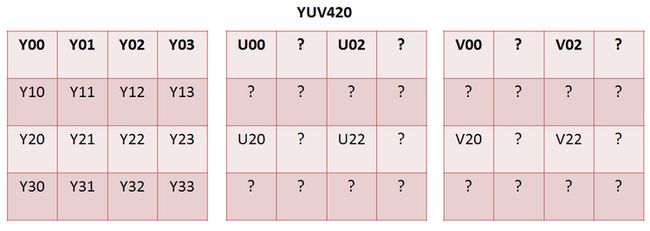Opengl ES中YUV420转RGB
Opengl ES中YUV420转RGB
一、先了解一个概念“灰度图”
1、灰度图的定义:
把白色与黑色之间按对数关系分为若干等级,称为灰度。灰度分为256阶。
2、举例:
老式黑白电视机的图像,即灰度图像
3、灰度值与RGB的计算公式:
Y = 0.299R + 0.587G + 0.114*B
4、这里有一个opengl es把彩色图片转化为灰度图的案例,效果如下:
转化的shader代码如下:
precision mediump float;
varying vec2 vTextureCoord;
uniform sampler2D sTexture;
void main() {
vec4 color=texture2D(sTexture, vTextureCoord);
//
float col=color.r*0.299+color.g*0.587+color.b*0.114;
//
color.r=col;
color.g=col;
color.b=col;
//
gl_FragColor =color;
}
代码中,将RGB色彩通道的数值设置为了计算出的灰度值。
二、YUV数据格式
1、YUV
Y:就是灰度值;
UV:用来指定像素的颜色。
2、使用YUV的好处:
- (1)、传输信号向后兼容老式黑白电视机(用于优化彩色视频信号的传输,使其向后相容老式黑白电视)
- (2)、YUV420占用的带宽少(为什么,后边来介绍)
YUV420与RGB视频信号传输相比,它最大的优点在于只需占用极少的频宽(后面来介绍)
3、YUV与RGB的关系
// RGB转YUV
Y= 0.299*R + 0.587*G + 0.114*B
U= -0.147*R - 0.289*G + 0.436*B = 0.492*(B- Y)
V= 0.615*R - 0.515*G - 0.100*B = 0.877*(R- Y)
//############################################
// YUV转RGB
R = Y + 1.140*V
G = Y - 0.394*U - 0.581*V
B = Y + 2.032*U
三、YUV444和YUV420
YUV444中,一个像素点对应一个Y一个U一个V,如下图所示:

YUV420中,一个像素点对应一个Y;四个像素点对应一个U一个V(Y、U、V没有一一对应,图像有颜色损失,但是占用的带宽也少了)
四、YUV420转RGB
YUV420转RGB要分两个步骤,
- 第一个步骤YUV420转YUV444;
- 第二个步骤YUV444转RGB。
1、YUV420转YUV444
要把YUV420转为YUV444就得把“图4 YUV420”中U与V中“?”的部分填满。
这里可以采用线性差值的方式,把像素点与Y、U、V一一对应,差值计算如下:
U01 = (U00 + U02)/2;
U10 = (U00 + U20)/2;
U11 = (U00 + U02 + U20 + U22)/4;
//######################
V01 = (V00 + V02)/2;
V10 = (V00 + V20)/2;
V11 = (V00 + V02 + V20 + V22)/4;
2、YUV444转RGB
直接用YUV转RGB的公式:
R = Y + 1.140*V
G = Y - 0.394*U - 0.581*V
B = Y + 2.032*U
说明:一、二、三、四,这四点介绍的是YUV转RGB的基本原理,下边是具体实现。
五、OpenGL ES中YUV420P转RGB
1、YUV420p的数据格式
YUV420p的数据格式如下图所示(为一个byte[]):

其中数据的4/6为Y;1/6为U;1/6为V。
2、YUV420sp的数据格式(YUV420sp转RGB这里不做介绍)
YUV420sp的数据格式如下图所示(为一个byte[]):

其中数据的4/6为Y;1/6为U;1/6为V。
3、YUV转RGB
- (1)、将一帧数据中的Y取出生成一张灰度图像、将U的数据取出生成一张图像、V的数据取出生成一张图像。
- (2)、将三张图像生成三张纹理图片传入“片元着色器”,YUV纹理如下图所示:
- (3)设置纹理采样方式为:线性采样
设置线性采样的作用即: 线性采样出U、V纹理中“?”部分的颜色值。这样就就可以拿到一一对应的YUV数据。
对应代码实现:
/**
*
* @param w
* @param h
* @param date
* 数据
* @param textureY
* @param textureU
* @param textureV
* @param isUpdate
* 是否为更新
*/
public static boolean bindYUV420pTexture(int frameWidth, int frameHeight,
byte frameData[], int textureY, int textureU, int textureV,
boolean isUpdate) {
if (frameData == null || frameData.length == 0) {
return false;
}
Log.d(TAG, "----bindYUV420pTexture-----");
if (isUpdate == false) {
/**
* 数据缓冲区
*/
// Y
ByteBuffer buffer = LeBuffer.byteToBuffer(frameData);
// GLES20.glActiveTexture(GLES20.GL_TEXTURE0);
GLES20.glBindTexture(GLES20.GL_TEXTURE_2D, textureY);
GLES20.glTexParameteri(GLES20.GL_TEXTURE_2D,
GLES20.GL_TEXTURE_MIN_FILTER, GLES20.GL_LINEAR);// GL_LINEAR_MIPMAP_NEAREST
GLES20.glTexParameteri(GLES20.GL_TEXTURE_2D,
GLES20.GL_TEXTURE_MAG_FILTER, GLES20.GL_LINEAR);
GLES20.glTexParameteri(GLES20.GL_TEXTURE_2D,
GLES20.GL_TEXTURE_WRAP_S, GLES20.GL_CLAMP_TO_EDGE);
GLES20.glTexParameteri(GLES20.GL_TEXTURE_2D,
GLES20.GL_TEXTURE_WRAP_T, GLES20.GL_CLAMP_TO_EDGE);
/**
* target 指定目标纹理,这个值必须是GL_TEXTURE_2D; level
* 执行细节级别,0是最基本的图像级别,n表示第N级贴图细化级别; internalformat
* 指定纹理中的颜色组件,可选的值有GL_ALPHA,GL_RGB,GL_RGBA,GL_LUMINANCE,
* GL_LUMINANCE_ALPHA 等几种; width 指定纹理图像的宽度; height 指定纹理图像的高度; border
* 指定边框的宽度; format 像素数据的颜色格式,可选的值参考internalformat; type
* 指定像素数据的数据类型,可以使用的值有GL_UNSIGNED_BYTE
* ,GL_UNSIGNED_SHORT_5_6_5,GL_UNSIGNED_SHORT_4_4_4_4
* ,GL_UNSIGNED_SHORT_5_5_5_1; pixels 指定内存中指向图像数据的指针;
*
*/
GLES20.glTexImage2D(GLES20.GL_TEXTURE_2D, 0, GLES20.GL_LUMINANCE,
frameWidth, frameHeight, 0, GLES20.GL_LUMINANCE,
GLES20.GL_UNSIGNED_BYTE, buffer);
/**
*
*/
// U
buffer.clear();
buffer = LeBuffer.byteToBuffer(frameData);
buffer.position(frameWidth * frameHeight);
//
// GLES20.glActiveTexture(GLES20.GL_TEXTURE1);
GLES20.glBindTexture(GLES20.GL_TEXTURE_2D, textureU);
GLES20.glTexParameteri(GLES20.GL_TEXTURE_2D,
GLES20.GL_TEXTURE_MIN_FILTER, GLES20.GL_LINEAR);// GL_LINEAR_MIPMAP_NEAREST
GLES20.glTexParameteri(GLES20.GL_TEXTURE_2D,
GLES20.GL_TEXTURE_MAG_FILTER, GLES20.GL_LINEAR);
GLES20.glTexParameteri(GLES20.GL_TEXTURE_2D,
GLES20.GL_TEXTURE_WRAP_S, GLES20.GL_CLAMP_TO_EDGE);
GLES20.glTexParameteri(GLES20.GL_TEXTURE_2D,
GLES20.GL_TEXTURE_WRAP_T, GLES20.GL_CLAMP_TO_EDGE);
GLES20.glTexImage2D(GLES20.GL_TEXTURE_2D, 0, GLES20.GL_LUMINANCE,
frameWidth / 2, frameHeight / 2, 0, GLES20.GL_LUMINANCE,
GLES20.GL_UNSIGNED_BYTE, buffer);
/**
*
*/
// V
buffer.clear();
buffer = LeBuffer.byteToBuffer(frameData);
buffer.position(frameWidth * frameHeight * 5 / 4);
//
// GLES20.glActiveTexture(GLES20.GL_TEXTURE2);
GLES20.glBindTexture(GLES20.GL_TEXTURE_2D, textureV);
GLES20.glTexParameteri(GLES20.GL_TEXTURE_2D,
GLES20.GL_TEXTURE_MIN_FILTER, GLES20.GL_LINEAR);// GL_LINEAR_MIPMAP_NEAREST
GLES20.glTexParameteri(GLES20.GL_TEXTURE_2D,
GLES20.GL_TEXTURE_MAG_FILTER, GLES20.GL_LINEAR);
GLES20.glTexParameteri(GLES20.GL_TEXTURE_2D,
GLES20.GL_TEXTURE_WRAP_S, GLES20.GL_CLAMP_TO_EDGE);
GLES20.glTexParameteri(GLES20.GL_TEXTURE_2D,
GLES20.GL_TEXTURE_WRAP_T, GLES20.GL_CLAMP_TO_EDGE);
GLES20.glTexImage2D(GLES20.GL_TEXTURE_2D, 0, GLES20.GL_LUMINANCE,
frameWidth / 2, frameHeight / 2, 0, GLES20.GL_LUMINANCE,
GLES20.GL_UNSIGNED_BYTE, buffer);
} else {
/**
* Y
*/
ByteBuffer buffer = LeBuffer.byteToBuffer(frameData);
GLES20.glBindTexture(GLES20.GL_TEXTURE_2D, textureY);
GLES20.glTexSubImage2D(GLES20.GL_TEXTURE_2D, 0, 0, 0, frameWidth,
frameHeight, GLES20.GL_LUMINANCE, GLES20.GL_UNSIGNED_BYTE,
buffer);
/**
* U
*/
//
buffer.clear();
buffer = LeBuffer.byteToBuffer(frameData);
buffer.position(frameWidth * frameHeight);
//
GLES20.glBindTexture(GLES20.GL_TEXTURE_2D, textureU);
GLES20.glTexSubImage2D(GLES20.GL_TEXTURE_2D, 0, 0, 0,
frameWidth / 2, frameHeight / 2, GLES20.GL_LUMINANCE,
GLES20.GL_UNSIGNED_BYTE, buffer);
/**
* V
*/
//
buffer.clear();
buffer = LeBuffer.byteToBuffer(frameData);
buffer.position(frameWidth * frameHeight * 5 / 4);
//
GLES20.glBindTexture(GLES20.GL_TEXTURE_2D, textureV);
GLES20.glTexSubImage2D(GLES20.GL_TEXTURE_2D, 0, 0, 0,
frameWidth / 2, frameHeight / 2, GLES20.GL_LUMINANCE,
GLES20.GL_UNSIGNED_BYTE, buffer);
}
return true;
}
代码说明:
已上代码便是将传入的帧数据byte frameData[],转为三张纹理图的代码。代码的16行、5051行、7576行分别为从byte frameData[]中分别取出Y、U、V数据的代码。代码5659行、代码8184行分别为设置U、V纹理的采样方式为线性采样的代码。以上代码运行结束,内存中会生成三张纹理图像。将三张纹理图像传入“片元着色器”执行下一步骤。
- (3)按照YUV转RGB的公式,将Y、U、V一一对应的取出,进行YUV转RGB操作,生成一个像素点。
对应代码:
precision mediump float;
uniform sampler2D sTexture_y;
uniform sampler2D sTexture_u;
uniform sampler2D sTexture_v;
varying vec2 vTextureCoord;
//公式转码
void getRgbByYuv(in float y, in float u, in float v, inout float r, inout float g, inout float b){
//
y = 1.164*(y - 0.0625);
u = u - 0.5;
v = v - 0.5;
//
r = y + 1.596023559570*v;
g = y - 0.3917694091796875*u - 0.8129730224609375*v;
b = y + 2.017227172851563*u;
}
void main() {
//
float r,g,b;
// 采样出YUV
float y = texture2D(sTexture_y, vTextureCoord).r;
float u = texture2D(sTexture_u, vTextureCoord).r;
float v = texture2D(sTexture_v, vTextureCoord).r;
// 转码公式
getRgbByYuv(y, u, v, r, g, b);
// 最终颜色赋值
gl_FragColor = vec4(r,g,b, 1.0);
}
代码说明:
代码26~28行便是,一一对应的采样出Y、U、V的数据,代码中getRgbByYuv(y,u,v,r,g,b)便是根据公式进行YUV转RGB操作的代码。



